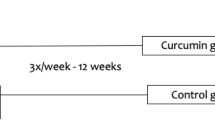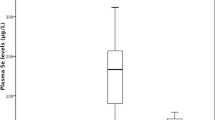Abstract
Purpose
Whey protein has antioxidant properties through its amino acid cysteine, which enhances the biosynthesis of glutathione, the most abundant antioxidant non-protein in mammalians. Glutathione influences vitamin C recycling and increases its protective effect on oxidative stress (OS). The aim of this study was to analyse the effect of whey protein and vitamin C supplementation on OS biomarkers in chronic haemodialysis (HD) patients.
Methods
This pioneer trial was a randomised, double-blind, pilot study in patients from a dialysis clinic. Patients were randomised into three groups (1:1:1) and stratified by HD frequency (2 or 3 times/week). Sachets containing protein powder (20.0 g) with/without vitamin C (0.25 g) or placebo (20.0 g of white rice flour) with vitamin C (0.25 g) were supplemented after each HD session, 3 times/week for 8 weeks. Blood samples were collected at the baseline period and after 8 weeks for the measurement of reduced glutathione (GSH), oxidised glutathione (GSSG), the GSH:GSSG ratio, malondialdehyde, vitamin C, and glutathione peroxidase-1.
Results
Twenty-two patients were enrolled, of which 18 concluded the trial, 6 per group (18.2%, n = 4 losses during follow-up). The vitamin C group presented decreased GSH levels after supplementation (p = 0.053) and a decreasing tendency in the GSH:GSSG ratio (non-statistically significant), while MDA levels significantly decreased only in the whey protein-supplemented groups (p ≤ 0.05).
Conclusion
The results suggest a pro-oxidant effect of 0.25 g of vitamin C alone in chronic HD patients.
Clinical trial registration
https://ensaiosclinicos.gov.br/, RBR-65b8f4.


Similar content being viewed by others
Data statement
The datasets generated and analysed during the current study are available from the corresponding author on reasonable request.
References
Liakopoulos V, Roumeliotis S, Gorny X et al (2017) Oxidative stress in hemodialysis patients: a review of the literature. Oxid Med Cell Longev 2017:1–22. https://doi.org/10.1155/2017/3081856
Borrelli S, Nicola L, Sagliocca A et al (2011) Amino acid loss during dialysis treatment. Giornale Italiano Di Nefrologia Organo Ufficiale Della Soc Italiana Di Nefrologia 28(1):26–31
Vaz I, de Freitas A, do Peixoto M et al (2014) Food intake in patients on hemodialysis. Revista De Nutrição 27(6):665–675. https://doi.org/10.1590/1415-52732014000600002
Bossola M, Luciani G, Rosa F et al (2011) Appetite and gastrointestinal symptoms in chronic hemodialysis patients. J Renal Nutr 21(6):448–454. https://doi.org/10.1053/j.jrn.2010.09.003
Lu S (2013) Glutathione synthesis. Biochimica Et Biophysica Acta Bba Gen Subj 1830(5):3143–3153. https://doi.org/10.1016/j.bbagen.2012.09.008
Meister A (1983) Glutathione. Annu Rev Biochem 52(1):711–760. https://doi.org/10.1146/annurev.bi.52.070183.003431
Richman PG, Meister A (1975) Regulation of gamma-glutamyl-cysteine synthetase by nonallosteric feedback inhibition by glutathione. J Biol Chem 250(4):1422–1426
Falkowski M, Maciejczyk M, Koprowicz T et al (2018) Whey protein concentrate wpc-80 improves antioxidant defense systems in the salivary glands of 14-month wistar rats. Nutrients 10(6):782. https://doi.org/10.3390/nu10060782
Ignowski E, Winter A, Duval N et al (2018) The cysteine-rich whey protein supplement, Immunocal®, preserves brain glutathione and improves cognitive, motor, and histopathological indices of traumatic brain injury in a mouse model of controlled cortical impact. Free Radical Biol Med 124:328–341. https://doi.org/10.1016/j.freeradbiomed.2018
Bumrungpert A, Pavadhgul P, Nunthanawanich P et al (2018) Whey protein supplementation improves nutritional status, glutathione levels, and immune function in cancer patients: a randomized. Double-Blind Controll Trial J Med Food 21(6):612–616. https://doi.org/10.1089/jmf.2017.4080
Winter A, Ross E, Daliparthi V et al (2017) A cystine-rich whey supplement (Immunocal®) provides neuroprotection from diverse oxidative stress-inducing agents in vitro by preserving cellular glutathione. Oxid Med Cell Longev 2017:3103272. https://doi.org/10.1155/2017/3103272
Cheng S-H, Tseng Y-M, Wu S-H et al (2017) Whey protein concentrate renders MDA-MB-231 cells sensitive to rapamycin by altering cellular redox state and activating GSK3β/mTOR signaling. Sci Rep UK 7(1):15976. https://doi.org/10.1038/s41598-017-14159-5
Moreno YF, Sgarbieri VC, da Silva MN et al (2006) Features of whey protein concentrate supplementation in children with rapidly progressive HIV infection. J Trop Pediatr 52(1):34–38. https://doi.org/10.1093/tropej/fmi074
Grey V, Mohammed S, Smountas A et al (2003) Improved glutathione status in young adult patients with cystic fibrosis supplemented with whey protein. J Cyst Fibros 2(4):195–198. https://doi.org/10.1016/S1569-1993(03)00097-3
Forman H, Zhang H, Rinna A (2009) Glutathione: overview of its protective roles, measurement, and biosynthesis. Mol Aspects Med 30(1–2):1–12. https://doi.org/10.1016/j.mam.2008.08.006
Shang F, Lu M, Dudek E et al (2003) Vitamin C and vitamin E restore the resistance of GSH-depleted lens cells to H2O2. Free Radical Bio Med 34(5):521–530. https://doi.org/10.1016/S0891-5849(02)01304-7
Chang SK, Ismail DZAM (2016) Encyclopedia of Food and Health. Sci Direct. https://doi.org/10.1016/B978-0-12-384947-2.00044-1
Sohrabi Z, Eftekhari M, Eskandari M et al (2016) Intradialytic oral protein supplementation and nutritional and inflammation outcomes in hemodialysis: a randomized controlled trial. Am J Kidney Dis 68(1):122–130. https://doi.org/10.1053/j.ajkd.2016.02.050
Abdollahzad H, Eghtesadi S, Nourmohammadi I et al (2009) Effect of vitamin C supplementation on oxidative stress and lipid profiles in hemodialysis patients. Int J Vitam Nutr Res 79(56):281–287. https://doi.org/10.1024/0300-9831.79.56.281
Washio K, Inagaki M, Tsuji M et al (2008) Oral vitamin C supplementation in hemodialysis patients and its effect on the plasma level of oxidized ascorbic acid and cu/Zn superoxide dismutase, an oxidative stress marker. Nephron Clin Pract 109(2):c49–c54. https://doi.org/10.1159/000137628
Ramos R, Martínez-Castelao A (2008) Lipoperoxidation and hemodialysis. Metabolis 57(10):1369–1374. https://doi.org/10.1016/j.metabol.2008.05.004
Fumeron C, Nguyen-Khoa T, Saltiel C et al (2005) Effects of oral vitamin C supplementation on oxidative stress and inflammation status in haemodialysis patients. Nephrol Dial Transpl 20(9):1874–1879. https://doi.org/10.1093/ndt/gfh928
Fouque D, Vennegoor M, Wee P et al (2007) EBPG guideline on nutrition. Nephrol Dial Transpl 22(suppl2):ii45–ii87. https://doi.org/10.1093/ndt/gfm020
Chumlea WC, Guo S, Roche AF et al (1988) Prediction of body weight for the nonambulatory elderly from anthropometry. J Am Diet Assoc 88:564–568
Steiber A, Leon J, Secker D et al (2007) Multicenter study of the validity and reliability of subjective global assessment in the hemodialysis population. J Renal Nutr 17(5):336–342. https://doi.org/10.1053/j.jrn.2007.05.004
Garcia M, Wazlawik E, Moreno Y et al (2013) Diagnostic accuracy of handgrip strength in the assessment of malnutrition in hemodialyzed patients. E-spen J 8(4):e181–e186. https://doi.org/10.1016/j.clnme.2013.06.003
Giustarini D, Dalle-Donne I, Milzani A et al (2013) Analysis of GSH and GSSG after derivatization with N-ethylmaleimide. Nat Protoc 8(9):1660–1669. https://doi.org/10.1038/nprot.2013.095
Wendel A (1981) Glutathione peroxidase. Sci Direct 325–333:325–333. https://doi.org/10.1016/S0076-6879(81)77046-0
Domijan A, Ralić J, Brkanac S et al (2015) Quantification of malondialdehyde by HPLC-FL: application to various biological samples. Biomed Chromatogr 29(1):41–46. https://doi.org/10.1002/bmc.3361
Emadi-Konjin P, Verjee Z, Levin A et al (2005) Measurement of intracellular vitamin C levels in human lymphocytes by reverse phase high performance liquid chromatography (HPLC). Clin Biochem 38(5):450–456. https://doi.org/10.1016/j.clinbiochem.2005.01.018
Hwang H, Hong Y, Yoon H et al (2016) Comparison of clinical outcome between twice-weekly and thrice-weekly hemodialysis in patients with residual kidney function. Medicine 95(7):e2767. https://doi.org/10.1097/md.0000000000002767
Minetti M, Forte T, Soriani M et al (1992) Iron-induced ascorbate oxidation in plasma as monitored by ascorbate free radical formation. No spin-trapping evidence for the hydroxyl radical in iron-overloaded plasma. Biochem J 282(2):459–465. https://doi.org/10.1042/bj2820459
Institute of medicine (IOM) (2000) Dietary reference intakes for vitamin C, vitamin E, selenium, and carotenoids. National Academies Press, Washington. https://doi.org/10.17226/9810
Wang S, Eide TC, Sogn EM et al (1999) Plasma ascorbic acid in patients undergoing chronic haemodialysis. Eur J ClinPharmacol 55(7):527–532. https://doi.org/10.1007/s002280050668
Dehghan M, Akhtar-Danesh N, McMillan C et al (2007) Is plasma vitamin C an appropriate biomarker of vitamin C intake? A systematic review and meta-analysis. Nutr J 6(1):41. https://doi.org/10.1186/1475-2891-6-41
Liakopoulos V, Roumeliotis S, Bozikas A et al (2019) Antioxidant supplementation in renal replacement therapy patients: is there evidence? Oxid Med Cell Long. https://doi.org/10.1155/2019/9109473
Dashti-Khavidaki S, Talasaz A, Tabeefar H et al (2011) Plasma vitamin C concentrations in patients on routine hemodialysis and its relationship to patients’ morbidity and mortality. Int J Vitam Nutr Res 81(4):197–203. https://doi.org/10.1024/0300-9831/a000065
McPherson R, Hardy G (2011) Clinical and nutritional benefits of cysteine-enriched protein supplements. Curr Opin Clin Nutr 14(6):562–568. https://doi.org/10.1097/MCO.0b013e32834c1780
Giulivi C, Cadenas E (1993) The reaction of ascorbic acid with different heme iron redox states of myoglobin. Febs Lett 332(3):287–290. https://doi.org/10.1016/0014-5793(93)80651-A
Candan F, Gültekin F, Candan F (2002) Effect of vitamin C and zinc on osmotic fragility and lipid peroxidation in zinc-deficient haemodialysis patients. Cell Biochem Funct 20(2):95–98. https://doi.org/10.1002/cbf.947
Acknowledgements
The authors are extremely grateful to all patients that volunteered to participate in this study, as well the hospital team. The authors would also like to thank the Baxter Novum research team at the Karolinska Institutet (Sweden) for receiving MLM as a visiting researcher and for contributing to the statistical analyses and data interpretation of this study. A special thanks to Bengt Lindholm, Abdul Rashid Qureshi and Carla Maria Avesani for all input given during the development of this manuscript. In addition, the authors would like to sincerely thank Biodora Pharmacy (Pharma & Phormula Farmacia de Manipulacao Eireli) and Risovita company for donating all the vitamin C and rice flour used in this study (respectively).
Funding
This study was financed in part by the Coordenação de Aperfeiçoamento de Pessoal de Nível Superior–CAPES (finance Code 001) and by the Postgraduate Program in Nutrition of the Federal University of Santa Catarina, Brazil.
Author information
Authors and Affiliations
Contributions
MLM, ATS, CM, and RPM performed data acquisition. MLM, ATS, RPM, and EW delineated the study design; MLM, HPR, TTS, and RPM performed laboratory analyses; ELS supervised laboratory analyses; MLM interpreted data, performed statistical analysis, and wrote the manuscript; EW was the supervisor of this study and critically revised the manuscript. All the authors have approved the final version of the manuscript.
Corresponding author
Ethics declarations
Conflict of interest
The authors declare that they have no conflicts of interest.
Additional information
Publisher's Note
Springer Nature remains neutral with regard to jurisdictional claims in published maps and institutional affiliations.
Supplementary Information
Below is the link to the electronic supplementary material.
Rights and permissions
About this article
Cite this article
Martins, M.L., da Silva, A.T., Machado, R.P. et al. Vitamin C decreases reduced glutathione in chronic haemodialysis patients: a pilot, randomised, double-blind trial. Int Urol Nephrol 53, 1695–1704 (2021). https://doi.org/10.1007/s11255-021-02797-8
Received:
Accepted:
Published:
Issue Date:
DOI: https://doi.org/10.1007/s11255-021-02797-8




